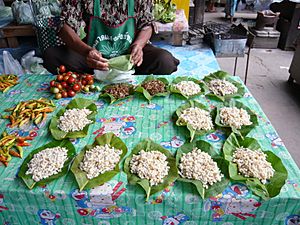Ant eggs facts for kids
Ant eggs are actually the eggs and young pupae (baby ants) of weaver ants. These ants are also known as red ants. People in several countries in Southeast Asia, especially Laos and Northeastern Thailand (Isan), enjoy eating them. Ant eggs are packed with protein and are liked for their slightly sour taste and a fun "pop" when you eat them. They are often added to soups, omelets, and salads.
There's a similar type of ant called Maeng mun. These ants live underground, and their eggs are also eaten, especially in northern Thailand.
Why Are Ant Eggs Good for You?
Ant eggs are a great source of protein. For example, 100 grams of ant eggs has more than 8.2 grams of protein. They also have less fat and fewer calories than regular chicken eggs. Ant eggs contain only about 2.6 grams of fat, while a chicken egg has more than 11.7 grams.
Ant eggs also give you important minerals like calcium, phosphorus, iron, sodium, and potassium. Plus, they have vitamins such as vitamin B1, vitamin B2, and Niacin.
How Are Ant Eggs Used in Food?
Red ant eggs are used in many different dishes. A very popular dish is Spicy Raw Ant Egg Salad, known as ก้อยไข่มดเเดง (Goi Khai Mot Daeng).
Because ant eggs contain acetic acid, they have a sour taste. This means they can be used instead of lemon juice or vinegar in many Thai recipes. This gives dishes a natural tanginess.
Ant egg soup is a traditional dish in Laos. However, it's becoming less popular with younger people there. You can even find ant eggs sold in cans!
How Are Ant Eggs Farmed?
Farming red ant eggs can be a helpful and inexpensive business for communities that don't have a lot of money. Many ant nests can be grown on a single tree, like a mango or palm tree. The ants are given extra food and sugar water to help them grow.
The time when ants lay eggs is usually from September to December and again from January to April. The eggs can be collected in May and June. When people collect the eggs, they are careful not to harm the rest of the nest or kill the ants that are still there. This helps make sure there will be more eggs in the future.


